Most people can agree that the 1989 cinematic adaptation of Stephen King’s novel Pet Sematary is pretty abysmal. The second adaptation of the film, which was widely released last Friday, is better than the first film, but that’s not saying much. Although the cinematography is adequate and the acting is mostly impressive, Pet Sematary (2019) is a disappointment that proves, as many critics have joked, that sometimes dead really is better.
Pet Sematary follows the Creed family as they move from Boston to a beautiful, barn-style house in Maine that comes with several unpleasant features, including the dangerously-placed highway adjacent to their property and the pet cemetery (misspelled as “sematary’ by the local kids) behind their house.
When the Creeds’ beloved cat, Church, is killed by a truck, their neighbor Jud encourages Louis, the father, to bury the cat in the swamp beyond the cemetery. As readers and viewers can suspect, Church doesn’t come back from the dead as the same sweet, docile cat from before. When tragedy strikes the Creed family, Louis makes a decision to go back to the land beyond the cemetery, with terrible consequences.
Although this may seem like a spoiler-laden summary, all of this information can be gleaned from the trailers for the film. In fact, the second trailer for the film reveals a significant change from the novel, which I won’t give away here. Although the reasoning behind the decision to move away from the novel makes sense, the trailers are too revealing and essentially give away the whole movie.
Though, in all honesty, there’s not that much to give away. The pacing is muddled and so is the plot. The third act is especially ridiculous, although it showcases some of the best acting in the movie. I rarely say this, but Pet Sematary could have benefited from 20 or 30 more minutes distributed throughout the film, for several reasons. The viewers aren’t made to care that much about the Creeds because of the subpar opening two-thirds of the film, and the horror of their situation is never fully realized because the ending is so rushed.
The viewer is distracted from the legitimately intriguing themes of grief and trauma that the film attempts to address by the excessive gore and jump-scares. Tension isn’t steadily sustained throughout the film, so Pet Sematary never becomes a truly successful horror movie.
I was mostly impressed by the acting. In particular, Amy Seimetz, who played the mom, and Jeté Laurence, who played 9-year-old Ellie, were excellent. Without giving too much away, it’s important to acknowledge that Laurence’s performance would be challenging for even the most seasoned actors. Unfortunately, Laurence’s and Seimetz’s performances are not enough to make Pet Sematary a good movie.
Pet Sematary suffers from messy pacing and plot, an over-reliance on horror movie tropes and a lack of true tension. Although it’s not an awful movie, it’s not very good either. Ultimately, both versions of Pet Sematary make the case that maybe some books are just not made to be adapted to the screen.








